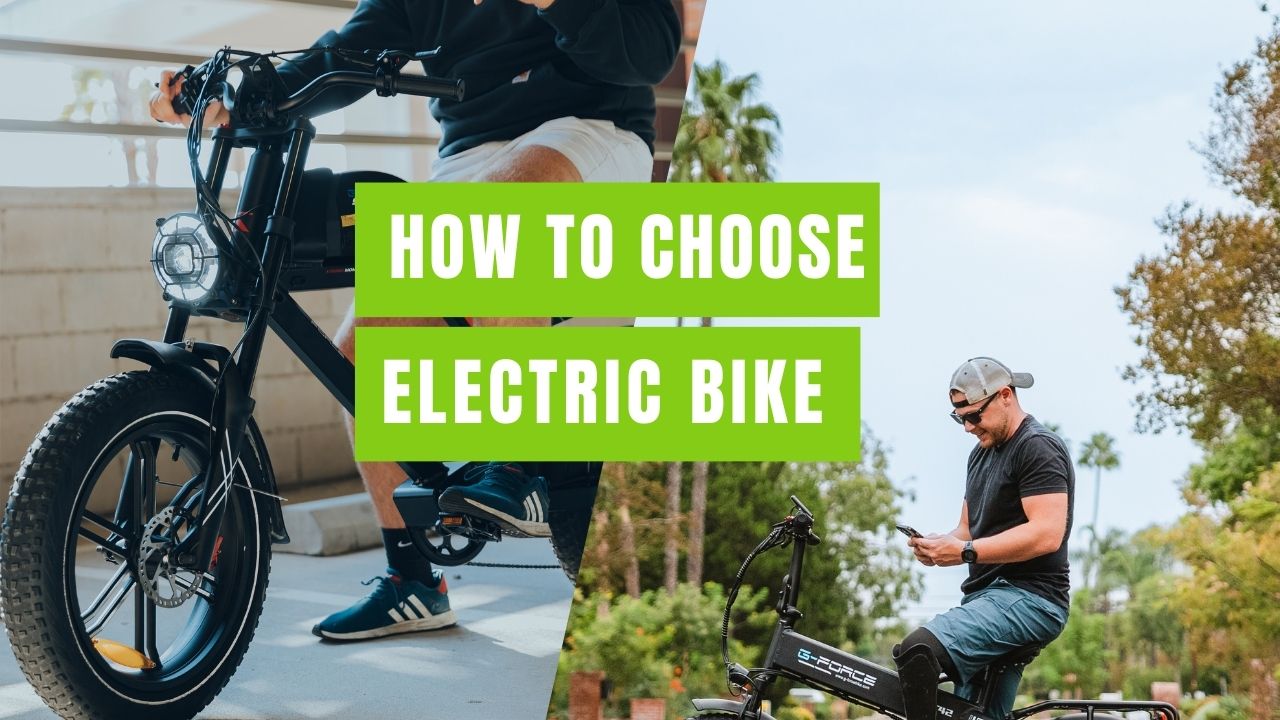Electric bikes (e-bikes) have surged in popularity in recent years, offering a sustainable, efficient, and fun way to get around. Whether you’re looking to commute, explore trails, or enjoy leisurely rides, there’s an e-bike out there for you. However, choosing the right one can be daunting with so many options available. This comprehensive guide will help you navigate through the process of selecting the perfect electric bike to meet your needs.
1. Determine Your Needs
- Purpose: Identify why you need an e-bike. Are you commuting to work, riding for recreation, tackling off-road trails, or using it for fitness purposes? This will narrow down the type of e-bike you should consider.
- Distance: Consider the distance you plan to travel on a typical ride. This will help determine the battery capacity and range required. For instance, commuting long distances will need a bike with a higher battery capacity.
2. Choose the Right Type of Electric Bike
- Commuter E-Bikes: These bikes are designed for daily commuting. They usually feature comfortable seating, integrated lights, and racks for carrying luggage.
- Mountain E-Bikes: Built for off-road adventures, these bikes have durable frames, advanced suspension systems, and robust tires to handle rough terrains.
- Folding E-Bikes: Ideal for urban environments where storage space is limited. They are compact and easy to carry on public transportation.
- Hybrid E-Bikes: These versatile bikes are suitable for both commuting and light off-road trails, offering a balance of features.
3. Understand the Motor Types
- Hub Motors: Located in the wheel hub, these motors are simpler and often more affordable. They are less powerful but suitable for flat terrains and city riding.
- Mid-Drive Motors: Positioned in the middle of the bike, these motors provide better weight distribution, improved performance on hills, and a more natural riding experience.
4. Consider the Battery
- Capacity: Measured in watt-hours (Wh), a higher capacity means a longer range. Consider how far you need to travel and choose a battery that meets those needs.
- Placement: Batteries can be integrated into the bike frame or mounted externally. Integrated batteries offer a sleeker appearance and are better protected from the elements.
5. Check the Bike’s Range
- Range: The range of an e-bike is the distance it can travel on a single charge. This varies based on the motor, battery, terrain, and riding style.
- Manufacturer’s Claims: While manufacturers provide range estimates, it’s important to compare these with real-world reviews and tests to get an accurate idea.
6. Look at the Bike’s Components
- Frame: Choose between aluminum, steel, or carbon fiber frames based on your preference for weight and durability. Aluminum is lightweight and affordable, steel is sturdy and comfortable, and carbon fiber is light but more expensive.
- Brakes: Disc brakes offer better stopping power, especially in wet conditions, compared to rim brakes.
- Gears: More gears provide better flexibility for tackling different terrains. Consider how hilly your rides will be and choose accordingly.
7. Test Ride Different Models
- Comfort: Make sure the bike fits your body and riding style. Adjust the saddle height, handlebar position, and ensure you feel comfortable.
- Performance: Test the bike’s acceleration, braking, and handling to ensure it meets your expectations. Pay attention to how the motor engages and the overall ride feel.
8. Consider Additional Features
- Display: Modern e-bikes come with displays showing speed, battery level, and range. Some even offer navigation and connectivity features.
- Lights and Reflectors: Essential for safety during night rides or low visibility conditions.
- Suspension: Front or full suspension systems provide a smoother ride on rough terrain, absorbing shocks and bumps.
9. Evaluate the Price
- Budget: E-bikes range from a few hundred to several thousand dollars. Set a budget based on your needs and stick to it.
- Value for Money: Compare features and specifications within your budget to ensure you’re getting the best value. Sometimes spending a bit more initially can save money on maintenance and replacements in the long run.
10. Read Reviews and Seek Recommendations
- Customer Reviews: Look for feedback from other buyers to understand the pros and cons of different models. Pay attention to comments about battery life, comfort, and durability.
- Expert Reviews: Check expert opinions for in-depth analysis and comparisons. They often highlight aspects you might not have considered.
11. Warranty and Support
- Warranty: Ensure the bike comes with a comprehensive warranty covering the motor and battery. This can save you from unexpected repair costs.
- Customer Support: Reliable customer service is crucial for maintenance and repairs. Check the manufacturer’s reputation for support and service.
12. Make Your Purchase
- Retailer: Buy from a reputable retailer with a good return policy and after-sales support. This ensures you have help if you encounter any issues.
- Accessories: Consider purchasing essential accessories like helmets, locks, and panniers for added convenience and safety.
Conclusion
Choosing the right electric bike involves careful consideration of your needs, the type of bike, motor and battery specifications, and additional features. By following these steps, you can find an e-bike that perfectly suits your lifestyle and riding habits. Remember to test ride different models, read reviews, and ensure you’re getting good value for your money. Happy riding
FAQ: How to Choose an Electric Bike
1. What type of electric bike should I choose for commuting? For commuting, a commuter e-bike is ideal. These bikes prioritize comfort and efficiency, often featuring comfortable seating, integrated lights, and racks for carrying luggage.
2. How do I determine the right battery capacity for my needs? Consider the average distance you plan to travel on a single charge. Battery capacity is measured in watt-hours (Wh); a higher capacity means a longer range. Choose a battery that can comfortably handle your typical ride distances.
3. What are the differences between hub motors and mid-drive motors? Hub motors are located in the wheel hub and are simpler and often more affordable, suitable for flat terrains and city riding. Mid-drive motors are positioned in the middle of the bike, providing better weight distribution, improved performance on hills, and a more natural riding experience.
4. How important is the range of an electric bike? The range is crucial as it determines how far you can travel on a single charge. Consider the manufacturer’s range estimates, but also look at real-world reviews to get a more accurate idea. Your range needs will depend on your intended use, such as commuting or recreational riding.
5. What frame materials are available for e-bikes, and which is best? Common frame materials include aluminum, steel, and carbon fiber. Aluminum is lightweight and affordable, steel is sturdy and comfortable, and carbon fiber is light but more expensive. Choose based on your preference for weight, durability, and budget.
6. Are disc brakes necessary for an electric bike? Disc brakes are highly recommended for e-bikes as they provide better stopping power, especially in wet conditions. They enhance safety and are more effective than traditional rim brakes.
7. How can I ensure the e-bike fits me properly? Test ride different models to ensure comfort. Adjust the saddle height and handlebar position to fit your body. Pay attention to the bike’s overall feel, including the motor engagement and ride quality.
8. What additional features should I consider when choosing an e-bike? Look for features such as a display showing speed, battery level, and range; integrated lights and reflectors for safety; and suspension systems for a smoother ride on rough terrain.
9. How do I evaluate the price and value of an electric bike? Set a budget based on your needs and compare features and specifications within that budget. Sometimes spending a bit more initially can save money on maintenance and replacements in the long run. Look for good value rather than just the lowest price.
10. Where should I buy my electric bike? Purchase from a reputable retailer with a good return policy and after-sales support. This ensures you have help if you encounter any issues. Consider customer and expert reviews before making a decision.
11. What should I look for in terms of warranty and customer support? Ensure the bike comes with a comprehensive warranty covering the motor and battery. Reliable customer service is crucial for maintenance and repairs. Check the manufacturer’s reputation for support and service.
12. Do I need any accessories for my electric bike? Yes, consider essential accessories like helmets for safety, locks for security, and panniers or baskets for carrying items. These accessories enhance convenience and safety while riding.

